Last Chance to Get It Right
Rule changes and the future of the Olympic Peninsula’s wild steelhead.
On Washington’s Olympic Peninsula, February is cold, dark and wet. Storms move inland from the Pacific Ocean and crash into the Olympic Mountains, shedding immense amounts of moisture in the process. Much of it is stored as snow at high elevation, but the rest washes through the landscape. Over the course of the year, the region can see up to 14 feet of cumulative precipitation, the vast majority of it in winter.
This endless rain defines the landscape. Vast forests grow from the saturated ground, nourished for millennia by the marine-derived nutrients delivered by salmon and steelhead bodies. Hundreds of species and textures of moss, lichen and fungi fill the understory, cling to tree branches and cover the trunks in mats. In places where the old growth was protected from the saw, the towering trees are centuries old and some stand over 200 feet tall.
The Olympic Peninsula (OP) is home to one of the last remnants of primeval temperate rain forest in the continental United States, but it is the rivers that draw anglers to the coast each winter. Named for the Indigenous peoples who’ve lived here for thousands of years, the Hoh, Queets, Quinault, Quillayute, Elwha and other rivers are volatile, wild watersheds with a powerful strain of large steelhead that evolved to migrate during the cold winter deluge.
These fish and their home waters are iconic among steelhead anglers across the world, celebrated in countless books, articles, essays, social-media posts, films and ads. Crowds have followed the accolades. Today, a large fleet of guides, anglers and a commercial tribal gillnet fishery all compete for the remaining fish.
Despite the enthusiasm and hype, or maybe because of it, the fish are slipping away. Their numbers have been falling for as long as we’ve kept track. For decades, fishery managers have had to be dragged kicking and screaming for them to show any effort to stop the bleeding or even publicly acknowledge the problem. They often claimed there was no reason to be concerned; only conceded to incremental limitations; offered sloppy, expensive hatchery interventions to obscure the losses; and otherwise defaulted to policies that guaranteed the most fish would be killed each season. As a result, many steelhead rivers on the Olympic Peninsula are close to requiring protection under the Endangered Species Act. Some would undoubtedly qualify right now if petitioned.
This winter, faced again with grim pre-season run forecasts, Washington fishery managers implemented a series of rules intended to dramatically decrease the number of steelhead caught by anglers and allow more fish to reach their spawning grounds.
The public reaction was contentious, to say the least. But for those watching these astounding fisheries grind toward catastrophe, it was a welcome shock to the system. The rules felt consequential. Maybe, just maybe, we might start taking the steps necessary to stop the loss of these incredible watersheds.
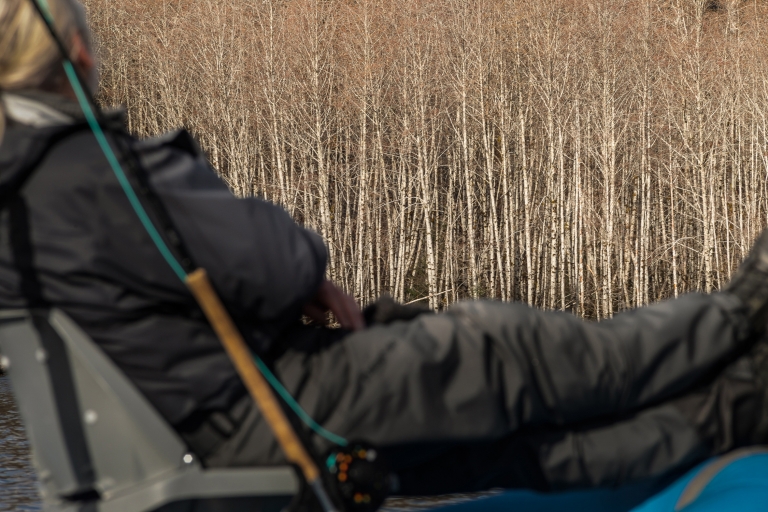
Naps on the boat? Absolutely. Casting from the boat? Absolutely not. Steve Duda recharges during a rare moment of fine weather on the Olympic Peninsula. Photo: Cameron Karsten
In December, as the winter steelhead season was kicking off, the Washington Department of Fish and Wildlife announced a series of emergency rule changes governing the entire steelhead fishery on Washington’s coastal and Olympic Peninsula streams. These new rules shortened the fishing season by a few weeks to protect spawning fish, eliminated the use of bait, required the use of single-point, barbless hooks and stopped the retention of rainbow trout in an effort to protect juvenile steelhead.
Most controversially, the rules implemented a blanket ban on fishing from a floating device. In practical terms, this meant that anglers could still use boats and rafts for transportation but now had to stop and get out to fish.
The rule is based on creel surveys showing anglers fishing from boats catch up to five times as many steelhead as wading anglers. Of course anglers fishing from boats catch many more fish. By fishing from a moving raft or drift boat, anglers can easily target every piece of holding water in a system. They can cover miles of river each day. Places that would be out of reach for a wading angler, no matter what gear they use, get pounded daily by multiple boats. Especially late in the season, when steelhead are holding in deep upriver pools waiting to spawn, they get caught multiple times. Studies on the Hoh and Sol Duc Rivers confirm that recreational anglers, averaged across the season, reported catching and releasing so many steelhead that it meant the entire run of fish was handled nearly twice.
We need to be honest with ourselves. Catch-and-release isn’t perfect, and injuries to fish accumulate. A number of fish get killed accidentally, and even those that survive can experience negative impacts to their spawning success, especially if they are caught repeatedly, knocked around in an effort to get a good photo for Instagram or have their gills out of the water for too long. They might be exhausted and not finish their migration or suffer poor egg production because of how stress hormones, like cortisol, accumulate in their bodies.
But it turns out, fishing from a comfortable boat instead of wading (and catching as many fish as possible) is very popular. In the weeks leading up to the department’s announcement and the months that followed, the steelhead angling community exploded. Debates raged between anglers who saw the rule as a reasonable compromise between limiting encounters and still allowing a season; those who saw it as an overreach that favored certain user groups over others; about claims that it penalized recreational anglers while doing nothing to stop tribal gillnet fisheries; and those who didn’t think it went far enough because it didn’t close particularly struggling rivers completely.
The opposition was led by vocal segments of the guide industry who saw their business model turned on its head overnight. Their clients were used to catching lots of big steelhead from boats, and they might not want to pay to go fishing if they couldn’t continue to do so.
There were public meetings with fishery managers, piles of emails and letters, an online petition to overturn the boat ban, hearings at the Washington State Legislature, a protest where guides and a few supporters pulled boats on trailers through the town of Forks, alternate plans proposed, countless posts on social media and online forums and, right as the rules were about to go into effect, a last-minute online meeting of the Washington Fish and Wildlife Commission with record attendance and large numbers of comments from both supporters and opponents of the rule change.
In the end, the rule changes stuck, and the winter season on Washington’s coast and Olympic Peninsula rivers got underway. Anglers and guides went fishing, perhaps more aware than ever of the precarious state of these public watersheds and their wild fish. For some of the older anglers, who’d lived through the collapse of the winter wild steelhead runs in Puget Sound, it must have felt eerily familiar.
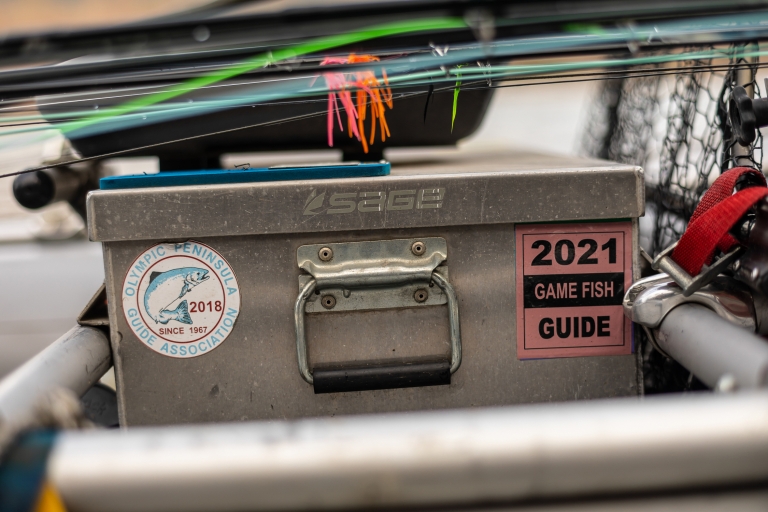
Get out and fish. New rules on Washington’s Olympic Peninsula no longer allow angling from a boat, raft or other floating devices. Photo: Cameron Karsten
Our crew met out on the coast to fish for three days. We floated three different sections of water and got absolutely drenched on the first and last days. The second day was one of those glorious moments on the OP when the rain holds off, fog banks drift through the rain forest and, instead of being obscured by clouds, the snow-covered Olympic Mountains glow when you turn and look upriver.
The water was cold and rising, but the rivers held long enough that we were able to find a pair of fish. The best one was a perfect winter hen, still a flawless pelagic chrome, returning home to natal waters after years spent hunting in the North Pacific. She was a quintessential wild steelhead: an inspiring animal and a humbling presence, a precise manifestation of what we’re fighting to protect on these coastal watersheds.
We were fishing with Gray Struznik, an exceptional angler, Spey caster and guide who was born and raised in Forks, Washington, and has fished the OP’s rivers his entire life. He’s also been a leader among the handful of guides who have committed to only swinging flies as a way to intentionally limit how many fish he catches each season.
I’d talked to him a couple times while the debates over the rule changes were raging. Since then, the new regulations had come into effect, and the season had been underway for a couple months. A few guides had already been caught cheating, and there had been a slight decrease in traffic on the rivers. Still, it was hard to know how much of that was due to the boat ban and how much was the result of the ongoing pandemic. I asked Struznik how he saw the new rules playing out as we fished a broad, slow tailout a few miles up from tidewater.
“Something had to give,” he said, shaking his head. “Everyone could see the writing on the wall. It shouldn’t have been a surprise to anyone that something like this was coming. For years we’ve just been catching too many fish. And the scary thing is, we kept catching them even though their numbers kept going down. We’ve created the most skilled steelhead anglers in history, with the best gear we’ve ever had. You can see flow data, maps and fishing reports on your phone. Or find instructional videos online to shorten the learning curve. Each year there are more people and more boats. Some days, I swear the rivers looked like a fishing derby. And everyone is out here trying as hard as possible to catch as many fish as they can. But, if we all want to keep fishing, the goal needs to be to catch fewer of them.”
This is the crux of what it means to be a steelhead angler on the Olympic Peninsula today: Can we embrace restraint and become guardians of these rivers and wild fish, instead of mobs of enthusiastic user groups? Long days of fishing give a guy plenty of time to dwell on this question. When I’m leaning against the current, and the fly is swinging through the cold water at the right speed, I find myself settling into a blend of gratitude and anticipation that I struggle to describe to anyone who isn’t an angler. Time seems to slow, and I feel connected to the river, the ancient cycle of fresh and saltwater, and the weight of what we have already lost. I want to believe that we can do better and demand better of our peers. If we can’t meet this higher standard, then the only option is for all of us to stop fishing here until we can adequately honor the privilege, and our responsibility, instead of taking it for granted.
Struznik offered an observation that has stuck with me. “Steelhead anglers need to shift their mindset. They need to start thinking like elk or deer hunters,” he explained. “Hunters know that if you use the most efficient tool—a rifle with a scope—you only get a short season because it is the easiest way to harvest one. Unless you have a special permit where populations are strong, you’re only allowed to shoot a buck. And only a single one.
But if you use less efficient tools, like a bow, you get to hunt a much longer season because it is less likely you’ll be able to get close enough to kill one. It is just that much harder to do. There are limits on the number of hunters allowed or a lottery for a few permits in lots of places. Hunters accept the situation because they know those limits keep these places from getting overrun and all the animals from getting killed. That’s what the boat ban is. It’s just limiting the most efficient tool on the river in order to give the fish a break and some places to rest. You can still fish whatever way you want, as long as you aren’t using bait, but it levels the playing field. You do it because that’s what is good for the fish.”
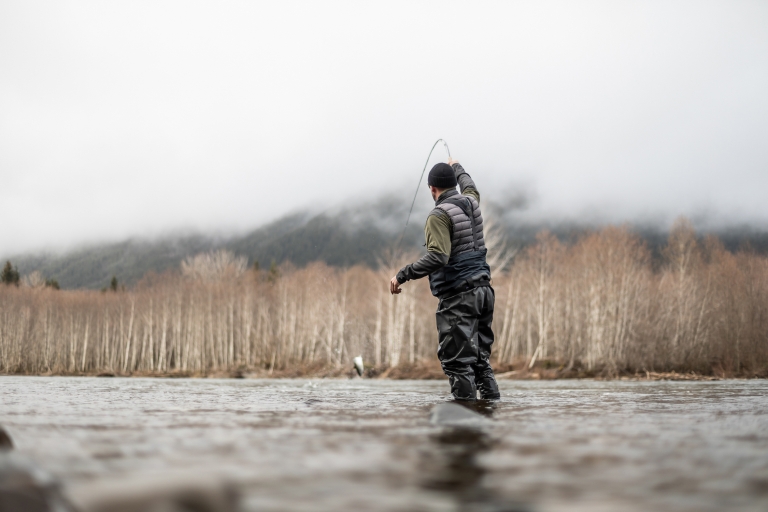
Gray Struznik swings up a wild steelhead on Washington’s Olympic Peninsula. Photo: Cameron Karsten
Engage with the steelhead fishing community online, either on forums or social media, and you’ll quickly be exposed to a wide variety of opinions about fishery management. Many will be written in capital letters. There will be a dose of conspiracy theories concerning conservation organizations, some strident calls for fish protection or dam removal, plenty of unhelpful fighting about gear types and a great deal of magical thinking about hatcheries. But in Washington, where fishery management and harvest allocations are legally split between the state and tribes, the most vitriolic commentary often centers on tribal ceremonial, subsistence and commercial salmon and steelhead fisheries.
It is a fraught topic rooted in the story of America and encompasses generations of resentment, injustice and conflict. Frankly, it is a difficult topic to engage. As an angler, it is tempting to not mention it when writing about steelhead fishing on the Olympic Peninsula, but avoiding it means we don’t have the difficult conversations required to build a genuinely sustainable path forward together. Ethically and legally, the future of wild steelhead on Washington’s coast must be shared between anglers and tribal fisheries. As our wild fish risk finally tipping toward collapse, we have to find ways to get it right before it is too late.
The Olympic Peninsula has been home to Indigenous peoples for millennia. Archaeological sites inside Olympic National Park document human activity going back 8,000 years. When a fossilized skeleton of a mastodon was discovered near Sequim, Washington, on the north coast of the OP, it revealed a sharp bone projectile stuck to one of its ribs that may have been crafted by prehistoric peoples. Researchers estimate the mastodon was alive 13,800 years ago.
In 1855 and 1856, the Treaty of Neah Bay, the Point No Point Treaty and the Quinault River Treaty (the Treaty of Olympia) transferred the lands of the Olympic Peninsula to the United States government and forced the Makah, Klallam, Chimakum, Skokomish, Quinault, Queets, Hoh and Quileute tribes onto reservations. The treaties were negotiated in bad faith by representatives of the federal government. Still, they explicitly confirmed the rights of the tribes to continue hunting and fishing in their “usual and accustomed grounds and stations.”
Tribal access to these lands and waters continued to be further restricted for a century following the treaties. The peninsula was divided into a national park, state and federal lands, vast private timberlands, farms and communities. Roads were carved into the forests, and the old-growth trees were razed, indiscriminately damaging hundreds of miles of spawning and rearing habitat in the process. Huge canneries appeared up and down the coast. With the tacit approval of state and federal governments, ruthless commercial fisheries harvested millions of tons of salmon and steelhead until the runs could no longer maintain the insane catch rates. In 1913 and 1927 two large dams were built without the legally required fish passage on the Elwha River, against the protests of the Lower Elwha Klallam Tribe, to provide power to the pulp and lumber mills near the city of Port Angeles.
In 1964, Nisqually tribal member Billy Frank Jr. and other Indigenous activists began a campaign to assert tribal treaty fishing rights in southern Puget Sound. They held “fish-ins” to protest Washington regulations prohibiting their fishing. The campaign continued for years, spurring arrests, violence and murky court rulings until 1974 when federal Judge George Boldt reconfirmed original tribal fishing rights and ruled that Indigenous tribes could take up to 50 percent of the harvestable fish and should be equally responsible for managing the fishing industry through a tribal fisheries commission, effectively creating co-management as we know it today. This ruling became known as the “Boldt Decision.” Immediately appealed, it was upheld in the Ninth US Circuit Court of Appeals a year later and affirmed by the Supreme Court in 1979.
It is a massive understatement to say that fishery co-management hasn’t always worked smoothly since the Boldt Decision. It is an immensely complicated negotiation representing multiple demands from public and commercial interests, all of whom want as much access to the fish as possible. Today, tribes and anglers cling to their share of the remaining wild steelhead, rightfully guarding against further losses.
For decades, anglers have killed large numbers of fish, but the steelhead fishery has been mandated catch-and-release since 2016. Now, our collective impacts are due to the sheer number of anglers handling so many steelhead. Tribal commercial fisheries use gillnets to harvest their share of wild and hatchery steelhead. Some tribes have reduced their seasons out of conservation concerns in recent years, but in the past, many of these fisheries frequently exceeded their allotted harvest numbers. Poaching also remains a persistent and frustrating problem across coastal and OP waters.
As a result of the profound ecological debts accumulated during the past century and a half, iconic rivers like the Hoh, Queets, Bogachiel, Quinault, Humptulips, Chehalis system and others have repeatedly missed spawning goals in recent years. Steelhead numbers in relative strongholds like the Sol Duc, Washington’s first river designated as a Wild Steelhead Gene Bank, and the Calawah are more encouraging but still far below historic levels. Our generation is tasked with restoring these watersheds and their wild fish populations, but we must face the challenge honestly, admit how we got to this point and find ways of sharing short-term sacrifices in exchange for the opportunity to rebuild.
Anglers and tribes have different cultural and economic relationships to these fish. The tribes were here first, and their fisheries are a profound connection to centuries of heritage and a powerful expression of sovereignty and treaty obligations. Contemporary recreational anglers arrived relatively recently and developed a passionate connection to these waters and fish. Wild steelhead, and the coast’s salmon, are our common ground and must be our shared lodestar.
It is good to remember that this isn’t lofty, empty platitudes or cheap political correctness. It is simply the only viable way forward. We know what can be accomplished when our communities work together instead of fighting over the last scraps. Ten years ago, on the Elwha River, the first charges of dynamite exploded, shattering concrete on the lower of two large dams to be removed over the next three years. It is the largest dam removal and river restoration project ever attempted, at least until the four dams on the Klamath River begin to be torn down. The Elwha restoration results from years of tireless work and collaboration between conservation organizations and the Lower Elwha Klallam Tribe.
We can, and should, continue to respectfully debate the role of hatcheries in the Elwha’s recovery. Still, the astounding resurgence of the river’s wild summer steelhead must be our clarion call: We can heal our rivers. The wild fish will fight to survive if we are wise and patient enough to let them.
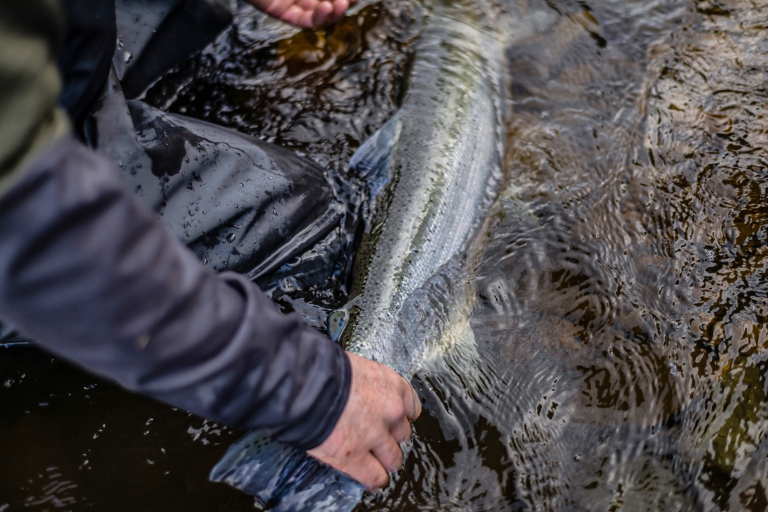
Head down, gills wet and good to go. Steve Duda releases a wild steelhead back to the Hoh River on Washington’s Olympic Peninsula. Photo: Cameron Karsten
This moment feels like a reckoning. One that is long overdue, honestly. For decades, biologists like John McMillan and Richard Burge have been warning us of what is being lost and what needs to be done to save the coast’s wild fish. Shane Anderson’s film Wild Reverence: The Wild Steelhead’s Last Stand was released seven years ago. Its lessons are still painfully relevant. Nonprofits and advocacy groups have been fighting for better policy and management and are working to restore habitat. Leaders in the angling community are working to reduce their personal impact and supporting regulations to change course before it is too late.
It is time for every one of us who fish these waters to do the same. In the debates about this season’s rule changes, I was struck by the argument that we need to keep anglers and guides on the water because we are the region’s stakeholders. As much as I want to keep fishing, just being a stakeholder is no longer good enough. We also need to become caretakers.
Sure, we show up and spend money at hotels, grocery stores, bars and local restaurants. Many of us hire guides. The guides, in turn, make their living from the public resource. If we’re lucky, we catch some fish and get some photos before heading home. But most of us don’t actually do anything to restore the rivers or safeguard the fish. We only exploit them for our entertainment. Surely, being a stakeholder should demand more accountability, especially when wild steelhead numbers on the coast are so low.
Sometimes I think it would be similar to a historical market hunter shooting the last passenger pigeon and then proudly explaining how they are the birds’ primary stakeholders.
Instead of arguing for more opportunities to keep pounding on fish, we should be fighting for policies that give their populations time to rebuild. We should be proud to catch fewer fish, even if that means closing rivers when it is necessary. And we should push back against anyone who says otherwise.
I don’t know if the boat ban will remain in place next season or not. I don’t even know if we’ll be able to fish next winter or not. But this year, with floating over water now effectively off-limits to angling, I was keenly aware of the sanctuary that had been created by the rule change. If the boat ban is removed, then anglers must demand it be replaced by other regulations that provide just as much protection, if not more. What we cannot do is go back to the free-for-all of the past. The time for that nonsense has passed.
When we are lucky enough to encounter a wild steelhead, landing them quickly and keeping their gills fully submerged are crucial to handling them responsibly. Catching fewer of them is an essential first step, but the long-term restoration of their numbers will depend on restoring their habitat and limiting the destructive effects of poor hatchery practices. Ideally, we’d see fewer grip-and-grin “hero shots” of wild steelhead being held out of the water and more photos of anglers bragging about their support for culverts being replaced, restored floodplains and riparian zones, and reconnected side-channel habitat.
Undoubtedly, tribal netting impacts wild steelhead numbers, but the tribes are also leaders in habitat restoration across coastal and OP watersheds. They have committed extensive resources to repairing the damage caused by generations of reckless logging and development. Anglers should find ways to support and emulate this work through the conservation organizations working on the coast.
This is especially true for the companies and guides profiting from these astounding rivers and fisheries. If a brand sells rods, waders or fishing trips with images of wild Olympic Peninsula steelhead, we should all be asking, what are you doing to also recover wild steelhead? How much money do you dedicate toward restoration? Tell me which projects you’re supporting. I don’t care about your hype or how many fish you catch. I want to know what you are doing to actually help heal these watersheds because I’m not interested in doing business with any company that isn’t.
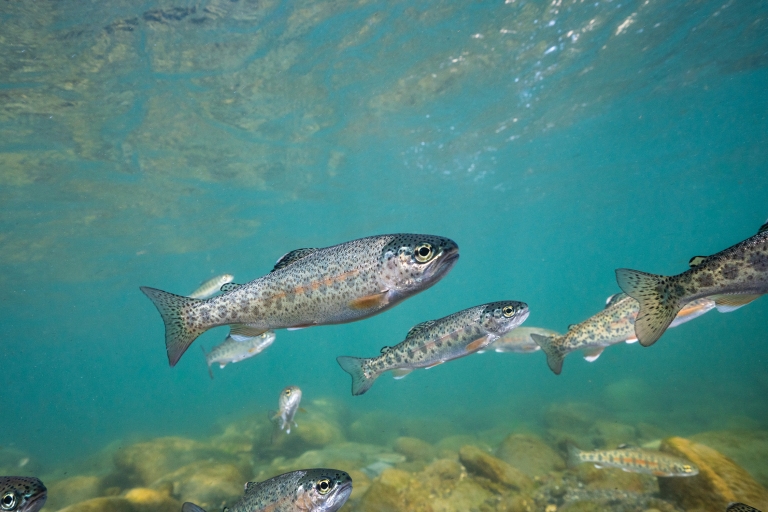
Their survival is our angling future—wild juvenile steelhead jockey for position in Washington State’s Elwha River. Photo: John McMillan
In many ways, we are lucky. The future of the Olympic Peninsula’s rivers is precarious. However, we still have wild fish returning here and exceptional habitat protected in their headwaters. The potential to restore damaged habitat outside of Olympic National Park is immense. If we proceed cautiously, we might be able to keep fishing a little. Still, our connection to these waters and their wild steelhead needs to motivate and inspire new efforts to restore, not just catch another fish, as great as an experience as that is.
We should let the shock of this winter’s rule changes snap us out of complacency and use this inherited moment to repair the mistakes of the past and race to head off the looming threats of the warming climate.
On one of the days when we were swinging flies and getting drenched, I was talking to Struznik about this. I knew he was someone who spoke up in public hearings, participated in advisory groups and didn’t sugarcoat the truth about the coast’s wild steelhead when talking with his clients and colleagues in the industry. In turn, many of his clients have become advocates and began speaking up in commission meetings, sending letters to fishery managers and making donations to conservation organizations.
“I want to share these rivers, but I want people to know how fragile this resource is,” Struznik explained. “When they leave after a fishing trip, I want them to know that this is a magical place, and it could be gone one day.”
He continued, “This is the first season in a long time where I have hope for this place. For years, it felt like we were just treading water and waiting to finally sink. It is a huge thing for the state to step up and make a change like this. I hope it is the start of a push to really get things right.
I’ve had incredible experiences on these rivers. And I made many of my best friends through steelhead fishing. I want to build a future around our wild fish. If I ever have a kid, I want them, or my friends’ kids, to be able to fish here and have those same experiences. I hope we took a step in the right direction for that to happen this winter.”
Support, Defend, Restore
How You Can Help Wild Steelhead
Help ensure that wild fish thrive in healthy Pacific Northwest waters by aiding Wild Steelhead Coalition’s work of building partnerships, educating stakeholders and helping to improve policy on behalf of these iconic fish.

